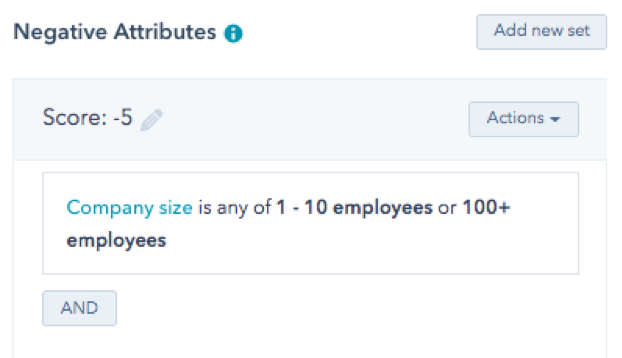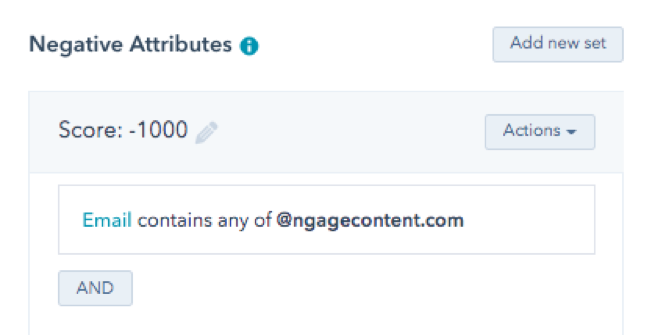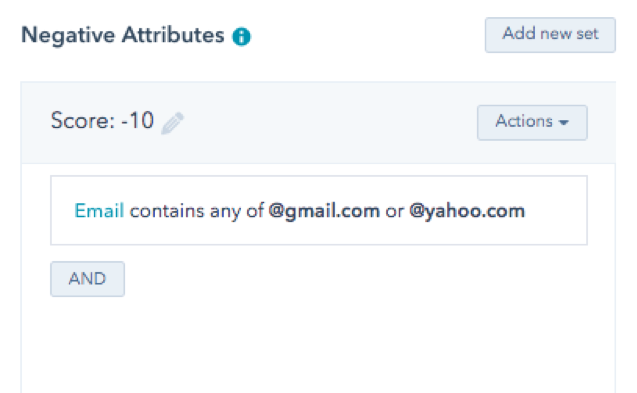
In the second blog of my HubSpot lead scoring series, I will be covering everything you need to know about negative scoring attributes! If you haven’t already, I suggest looking at my positive scoring blog before or after reading this one to get a complete understanding of scoring attributes and how they work.
What Are Negative Scoring Attributes?
As I mentioned above, if you’re not familiar with positive scoring attributes, be sure to refer back to the first blog of this series so you’ll be ready to understand and implement both.
While positive scoring attributes help you qualify prospects that take desirable actions, it’s also important to consider the attributes that don’t fit your definition of a qualified prospect.
HubSpot is only as smart as we tell it to be, so it will run with the rules that you set for every single contact in your database. Additionally, HubSpot does not consider who the prospect actually is unless we tell it to; it just looks at the data and the actions that they take.
Negative scoring attributes exist so that you can essentially exclude non-prospects from lead scoring and account for activities and properties that actually don’t make a prospect more qualified. This allows you to funnel out true, qualified leads from prospects that are unlikely to take the next steps.
Main Uses for Negative Scoring Attributes
When looking at negative scoring attributes, there are two main use cases that you should know. The first is excluding non-prospects from lead scoring, and the second is adjusting the scoring scale for prospects that have undesirable attributes.
When it comes to excluding non-prospects, a contact racking up a high score does not always guarantee that they are a legitimate qualified prospect, like in these instances:
- The contact is an internal team member
- The contact is a friend or relative
- The contact is spam (from a spam form submission about improving your SEO)
- The contact is your accountant/lawyer/marketing agency/vendor/etc.
- The contact is a competitor keeping tabs on you
In these cases, those contacts would likely meet your positive scoring attributes by opening and clicking on emails regularly, checking out your website and blog regularly, and downloading your content offers.
However, they’re not people that your sales team should be pursuing, and any activity notifications around their activity to your sales team distract from your actual qualified prospects.
While you can’t entirely exclude these contacts from the lead scoring rules, you can ensure that their activity will never trigger an internal email for the sales team by using negative attributes.
The Most impactful Negative Scoring Attributes
The most impactful negative attribute is subtracting points if the contact’s email address includes the domain of your company, your partner companies, spam companies, friend or relative’s companies, competitors’ companies, and so on.

This is an example of subtracting points based on undesirable property values. This doesn’t seek to disqualify the prospect completely. It simply raises the bar for positive actions needed to trigger a notification for the sales team.
You can subtract as many points as you’d like to ensure that the contact will never trigger a notification. For example, we’ll subtract 1,000 points if their email domain belongs to a non-prospect.
Even though they’ll still be taking desirable actions, they’re essentially factored out of lead scoring and will never be sent to the sales team to pursue.

This is an example of someone we, for instance, wouldn’t want to include in lead scoring since we know they’re not a prospect as they are from our company. Even though they’ll still be taking positive actions, they won’t be enough to reach the score that triggers the notification for sales.
You may also want to hold different prospects to different scoring requirements based on factors like:
- Their industry
- Their company size/annual revenue
- Last mail open (if no activity in 6-9 months, it could make sense to subtract points)
- Their email domain (if it’s a personal email address @gmail, yahoo, etc.)
- Their email activity (unsubscribed)
- Any custom property (i.e., number of voicemails left, trade show attendance)
While any of these could completely disqualify a prospect, such as a score of -1,000 points, depending on your organization, they’re more so meant to account for the undesirable attributes so that more positive actions must be taken before they’re passed on to the sales team.
This helps assign lead scoring priority. So if two contacts take the same exact activity, but one has a desirable company size and the other has an undesirable company size, the sales team will be notified about the desirable one first.

As shown in the screenshot above, this negative scoring sets them back more, but they can come back and show that they’re engaged even though they’re using a personal email address.
If the less desirable contacts keep taking additional positive actions, the sales team will be notified. Even though they may not have the most desirable company size, they’ve shown that they’re engaged enough to have made up for the points they initially lost.
TALK WITH US TO GET STARTED
As you begin your own journey to set up a CRM and qualifying leads, you may find that you would like to speak with an expert to get you started.
Whether you’re just getting started with HubSpot or are looking to get the most out of your current setup, we would be happy to help. Contact us today so we can get started!
